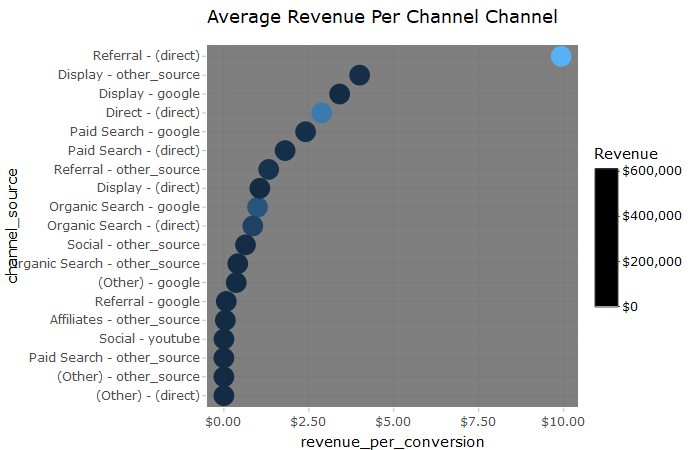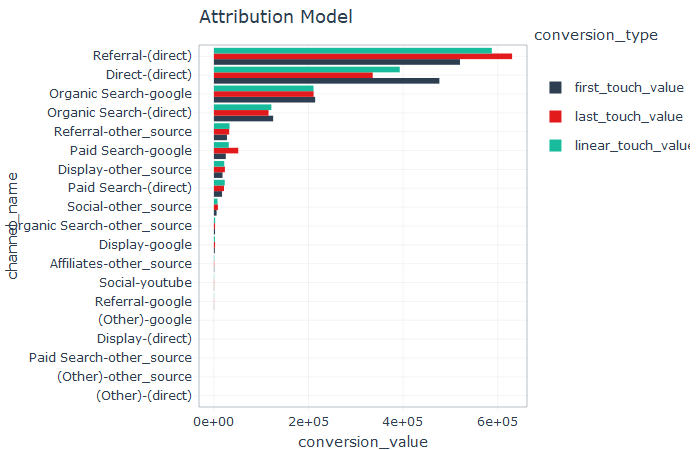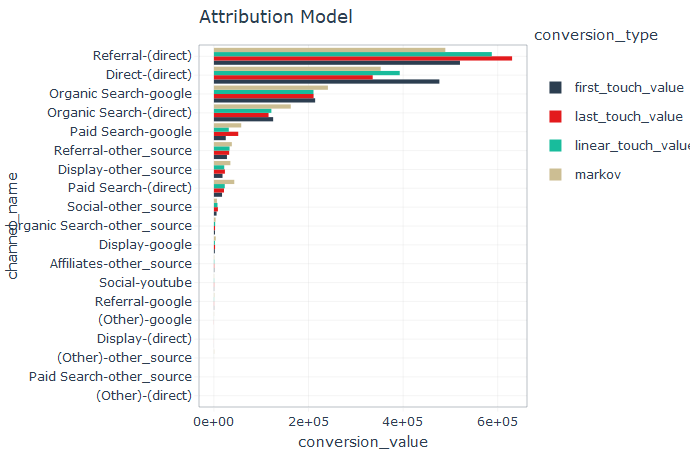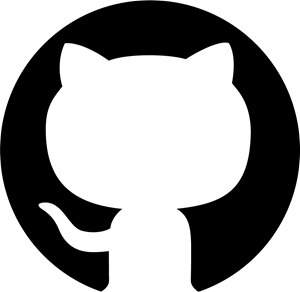Marketing Channel Attribution
1. Business Problem
We will be looking at Google Merchandise Store https://shop.googlemerchandisestore.com/ Customer who loves Google Products can buy tees, jackets and others swags from this website. In the website, Google Analytics tracks every event on the website. They do have multiple tocuh-points like Youtube, Google Ads, Referaal links etc.
Google has shared the data set (after normalization) in Google Big Query and we can use this data for Channel Attribution
1.1 Problem Statement
There are multiple Conversion Model that are widely used in Marketing domains. Below are some of them:
- First Interaction
- Last Interaction
- Time Decay Interaction
- Linear Interaction
We can use any of the Heuristic Models and mostly used in the industry is the Last Touch Model. The problem in the heuristic model is not to consider all the different channels from the application, which will hurt the overall conversion funnel.
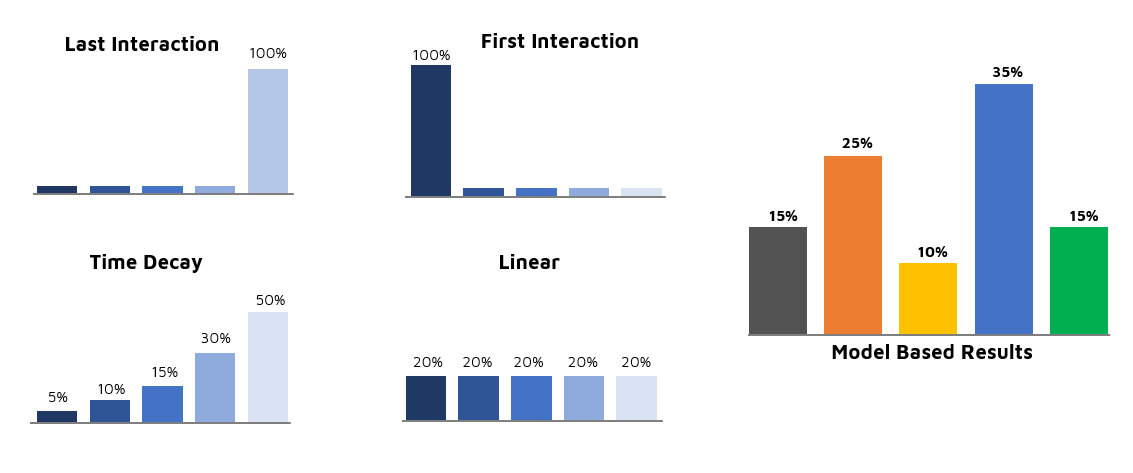 source: https://github.com/MatCyt/Markov-Chain
source: https://github.com/MatCyt/Markov-Chain
The solution in this case study is to capture the whole journey by using Markov Chain.
1.2 Data
We are fetching the daata from Google BigQuery in public data set freely avaible. Below is the query to fetch data:
# Databases
#library(bigrquery)
library(DBI)
#library(connections)
library(jsonlite)
# Core
library(tidyverse)
## -- Attaching packages --------------------------------------------------------------------------------------------- tidyverse 1.3.0 --
## v ggplot2 3.2.1 v purrr 0.3.3
## v tibble 2.1.3 v dplyr 0.8.4
## v tidyr 1.0.2 v stringr 1.4.0
## v readr 1.3.1 v forcats 0.4.0
## -- Conflicts ------------------------------------------------------------------------------------------------ tidyverse_conflicts() --
## x dplyr::filter() masks stats::filter()
## x purrr::flatten() masks jsonlite::flatten()
## x dplyr::lag() masks stats::lag()
library(tidyquant)
## Loading required package: lubridate
##
## Attaching package: 'lubridate'
## The following object is masked from 'package:base':
##
## date
## Loading required package: PerformanceAnalytics
## Loading required package: xts
## Loading required package: zoo
##
## Attaching package: 'zoo'
## The following objects are masked from 'package:base':
##
## as.Date, as.Date.numeric
##
## Attaching package: 'xts'
## The following objects are masked from 'package:dplyr':
##
## first, last
##
## Attaching package: 'PerformanceAnalytics'
## The following object is masked from 'package:graphics':
##
## legend
## Loading required package: quantmod
## Loading required package: TTR
## Version 0.4-0 included new data defaults. See ?getSymbols.
library(lubridate)
library(plotly)
##
## Attaching package: 'plotly'
## The following object is masked from 'package:ggplot2':
##
## last_plot
## The following object is masked from 'package:stats':
##
## filter
## The following object is masked from 'package:graphics':
##
## layout
# dplyr helpers
library(dbplyr)
##
## Attaching package: 'dbplyr'
## The following objects are masked from 'package:dplyr':
##
## ident, sql
# Attribution
library(ChannelAttribution)
query <- "
SELECT fullVisitorId, date, channelGrouping,
trafficSource.source AS traffic_source,
SUM ( totals.transactions ) AS total_transactions,
SUM ( totals.totalTransactionRevenue ) AS total_transaction_revenue
FROM `bigquery-public-data.google_analytics_sample.ga_sessions_*`
GROUP BY fullVisitorId, date, channelGrouping, traffic_source;
"
1.3 Data Cleaning
In case, you don’thave bigQuery. I am sharing the bigQuery results in CSV file.
# Incase you don't need to run BigQuery; Use csv
query_tbl <- read_csv("data/bigquery_data.csv")
## Parsed with column specification:
## cols(
## fullVisitorId = col_character(),
## date = col_double(),
## channelGrouping = col_character(),
## traffic_source = col_character(),
## total_transactions = col_double(),
## total_transaction_revenue = col_double()
## )
query_tbl %>%
count(channelGrouping, traffic_source, sort = TRUE)
## # A tibble: 287 x 3
## channelGrouping traffic_source n
## <chr> <chr> <int>
## 1 Organic Search google 212125
## 2 Social youtube.com 209881
## 3 Organic Search (direct) 137501
## 4 Direct (direct) 131037
## 5 Referral (direct) 61801
## 6 Affiliates Partners 15062
## 7 Referral analytics.google.com 14328
## 8 Paid Search google 11592
## 9 Paid Search (direct) 10913
## 10 Display dfa 4935
## # ... with 277 more rows
query_tbl %>% count(channelGrouping, sort = TRUE)
## # A tibble: 8 x 2
## channelGrouping n
## <chr> <int>
## 1 Organic Search 356052
## 2 Social 222610
## 3 Direct 131037
## 4 Referral 94410
## 5 Paid Search 22506
## 6 Affiliates 15062
## 7 Display 5440
## 8 (Other) 107
query_tbl %>% count(traffic_source, sort = TRUE)
## # A tibble: 275 x 2
## traffic_source n
## <chr> <int>
## 1 (direct) 341327
## 2 google 224182
## 3 youtube.com 209881
## 4 Partners 15069
## 5 analytics.google.com 14328
## 6 dfa 4935
## 7 google.com 4443
## 8 baidu 3287
## 9 m.facebook.com 3275
## 10 sites.google.com 2735
## # ... with 265 more rows
query_tbl %>% count(traffic_source, sort = TRUE) %>% glimpse()
## Observations: 275
## Variables: 2
## $ traffic_source <chr> "(direct)", "google", "youtube.com", "Partners"...
## $ n <int> 341327, 224182, 209881, 15069, 14328, 4935, 444...
g <- query_tbl %>%
# Cleaning
mutate(traffic_source_clean = traffic_source %>%
str_to_lower() %>%
str_replace("\\.com", "") %>%
str_replace("^m\\.", "")) %>%
mutate(traffic_source_clean = case_when(
str_detect(traffic_source_clean, "\\.google") ~ "google_product",
str_detect(traffic_source_clean, "google\\.") ~ "google",
str_detect(traffic_source_clean, "facebook") ~ "facebook",
TRUE ~ traffic_source_clean
)) %>%
mutate(traffic_source_clean = traffic_source_clean %>%
as_factor() %>%
fct_lump(n = 3, other_level = "other_source")) %>%
# Aggregating
count(traffic_source_clean) %>%
arrange(desc(n)) %>%
mutate(traffic_source_clean = fct_reorder(traffic_source_clean, n)) %>%
# Visualizing
ggplot(aes(traffic_source_clean, n)) +
geom_point(size = 5, color='darkblue') +
coord_flip() +
expand_limits(y = 0)
ggplotly(g)
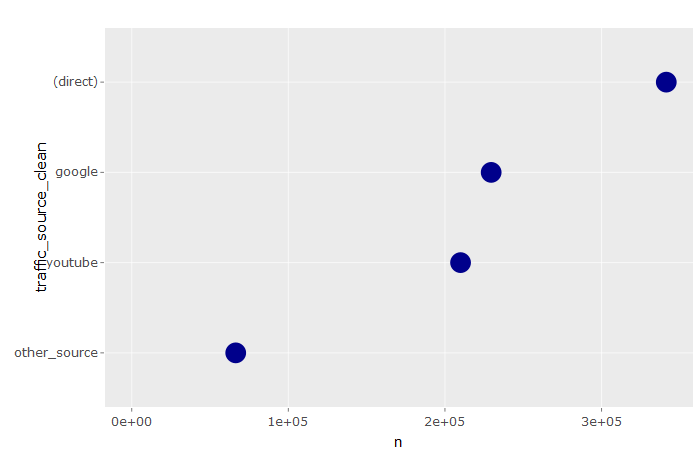
I have defined into four categories : Direct , Google , Youtube and others (all other sources are added in this group.)
# Apply Cleaning Steps
query_clean_tbl <- query_tbl %>%
mutate(traffic_source_clean = traffic_source %>%
str_to_lower() %>%
str_replace("\\.com", "") %>%
str_replace("^m\\.", "")) %>%
mutate(traffic_source_clean = case_when(
str_detect(traffic_source_clean, "\\.google") ~ "google_product",
str_detect(traffic_source_clean, "google\\.") ~ "google",
str_detect(traffic_source_clean, "facebook") ~ "facebook",
TRUE ~ traffic_source_clean
)) %>%
mutate(traffic_source_clean = traffic_source_clean %>%
as_factor() %>%
fct_lump(n = 3, other_level = "other_source"))
query_clean_tbl %>% count(channelGrouping, traffic_source_clean, sort = TRUE)
## # A tibble: 19 x 3
## channelGrouping traffic_source_clean n
## <chr> <fct> <int>
## 1 Organic Search google 212125
## 2 Social youtube 209971
## 3 Organic Search (direct) 137501
## 4 Direct (direct) 131037
## 5 Referral (direct) 61801
## 6 Referral other_source 27276
## 7 Affiliates other_source 15062
## 8 Social other_source 12639
## 9 Paid Search google 11592
## 10 Paid Search (direct) 10913
## 11 Organic Search other_source 6426
## 12 Referral google 5333
## 13 Display other_source 4935
## 14 Display google 432
## 15 Display (direct) 73
## 16 (Other) other_source 72
## 17 (Other) google 33
## 18 (Other) (direct) 2
## 19 Paid Search other_source 1
2. Understand Value by Channel-Source - Attribution Analysis
# Attribution Analysis
channel_value_tbl <- query_clean_tbl %>%
group_by(channelGrouping, traffic_source_clean) %>%
summarize(
n = n(),
total_transactions = sum(as.numeric(total_transactions), na.rm = TRUE),
total_transaction_revenue = sum(as.numeric(total_transaction_revenue), na.rm = TRUE) / 1e6
) %>%
mutate(revenue_per_conversion = total_transaction_revenue / n) %>%
ungroup() %>%
arrange(desc(total_transaction_revenue))
channel_value_tbl
## # A tibble: 19 x 6
## channelGrouping traffic_source_~ n total_transacti~
## <chr> <fct> <int> <dbl>
## 1 Referral (direct) 61801 5348
## 2 Direct (direct) 131037 2219
## 3 Organic Search google 212125 2174
## 4 Organic Search (direct) 137501 1360
## 5 Referral other_source 27276 190
## 6 Paid Search google 11592 248
## 7 Display other_source 4935 132
## 8 Paid Search (direct) 10913 231
## 9 Social other_source 12639 120
## 10 Organic Search other_source 6426 47
## 11 Display google 432 18
## 12 Affiliates other_source 15062 9
## 13 Referral google 5333 5
## 14 Social youtube 209971 11
## 15 Display (direct) 73 2
## 16 (Other) google 33 1
## 17 (Other) (direct) 2 0
## 18 (Other) other_source 72 0
## 19 Paid Search other_source 1 0
## # ... with 2 more variables: total_transaction_revenue <dbl>,
## # revenue_per_conversion <dbl>
3. Data Visulization
3.1 Visualize Average Revenue Per Channel
#Visualize Average Revenue Per Channel
g <- channel_value_tbl %>%
# Make plot labels and sort order
mutate(point_text = str_glue("Total Revenue: {scales::dollar(total_transaction_revenue)}
Revenue Per Entry: {scales::dollar(revenue_per_conversion)}")) %>%
mutate(channel_source = str_glue("{channelGrouping} - {traffic_source_clean}")) %>%
mutate(channel_source = as_factor(channel_source) %>% fct_reorder(revenue_per_conversion)) %>%
# Visualize
ggplot(aes(channel_source, revenue_per_conversion)) +
geom_point(aes(text = point_text, color = total_transaction_revenue), size = 5) +
coord_flip() +
scale_y_continuous(labels = scales::dollar_format()) +
scale_color_continuous(labels = scales::dollar_format()) +
labs(title = "Average Revenue Per Channel Channel", color = "Revenue") +
theme_dark()
## Warning: Ignoring unknown aesthetics: text
ggplotly(g, tooltip = "text")
3.2 Visualize Total Revenue Per Channel
g <- channel_value_tbl %>%
# Make plot labels and sort order
mutate(point_text = str_glue("Total Revenue: {scales::dollar(total_transaction_revenue)}
Revenue Per Entry: {scales::dollar(revenue_per_conversion)}")) %>%
mutate(channel_source = str_glue("{channelGrouping} - {traffic_source_clean}")) %>%
mutate(channel_source = as_factor(channel_source) %>% fct_reorder(total_transaction_revenue)) %>%
# Visualize
ggplot(aes(channel_source, total_transaction_revenue)) +
geom_point(aes(text = point_text, color = revenue_per_conversion), size = 5) +
coord_flip() +
scale_y_continuous(labels = scales::dollar_format()) +
scale_color_continuous(labels = scales::dollar_format()) +
labs(title = "Total Revenue Per Channel Channel", color = "RPE") +
theme_dark()
## Warning: Ignoring unknown aesthetics: text
ggplotly(g, tooltip = "text")
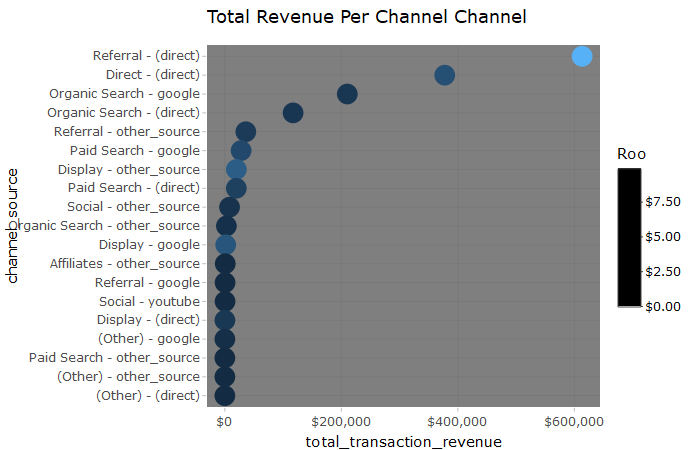
4. Data volume is in ~700K rows and used dtplyr (big data for data table)
query_dtplyr <- query_clean_tbl %>% dtplyr::lazy_dt()
visitor_date_channelgrouping_dtplyr <- query_dtplyr %>%
# Fix date from BigQuery
mutate(date = ymd(date)) %>%
# Add Channel-Traffic Source Combo
mutate(channel_source = str_c(channelGrouping, "-", traffic_source_clean)) %>%
# Select Important columns
select(fullVisitorId, date, channel_source, total_transactions, total_transaction_revenue) %>%
# Fix revenue
mutate(total_transaction_revenue = total_transaction_revenue / 1e6) %>%
# Path Calculations
group_by(fullVisitorId, date, channel_source) %>%
mutate(total_transactions = sum(total_transactions, na.rm = TRUE)) %>%
mutate(total_transaction_revenue = sum(total_transaction_revenue, na.rm = TRUE)) %>%
arrange(date) %>%
ungroup() %>%
# Binary Conversion (Yes/No)
mutate(total_transactions = ifelse(total_transactions > 0, 1, 0))
visitor_date_channelgrouping_tbl <- as_tibble(visitor_date_channelgrouping_dtplyr)
visitor_date_channelgrouping_tbl
## # A tibble: 847,224 x 5
## fullVisitorId date channel_source total_transacti~
## <chr> <date> <chr> <dbl>
## 1 000722514342~ 2016-08-01 Direct-(direc~ 0
## 2 001465993518~ 2016-08-01 Social-youtube 0
## 3 001569443280~ 2016-08-01 Direct-(direc~ 0
## 4 001747219368~ 2016-08-01 Organic Searc~ 0
## 5 001852659575~ 2016-08-01 Social-youtube 0
## 6 001998304603~ 2016-08-01 Direct-(direc~ 0
## 7 002597793543~ 2016-08-01 Social-youtube 0
## 8 002855959112~ 2016-08-01 Direct-(direc~ 0
## 9 003065339361~ 2016-08-01 Social-youtube 0
## 10 003651776577~ 2016-08-01 Social-youtube 0
## # ... with 847,214 more rows, and 1 more variable:
## # total_transaction_revenue <dbl>
channel_path_dtplyr <- visitor_date_channelgrouping_dtplyr %>%
group_by(fullVisitorId) %>%
summarize(
channel_path = str_c(channel_source, collapse = " > "),
conversion_total = sum(total_transactions),
conversion_null = sum(total_transactions == 0),
conversion_value = sum(total_transaction_revenue),
n_channel_path = n()
) %>%
ungroup()
channel_path_tbl <- channel_path_dtplyr %>% as_tibble()
# Longest Channel Path?
channel_path_tbl %>% arrange(desc(n_channel_path))
## # A tibble: 714,167 x 6
## fullVisitorId channel_path conversion_total conversion_null
## <chr> <chr> <dbl> <int>
## 1 195745897629~ Organic Sea~ 14 132
## 2 360847519334~ Paid Search~ 1 130
## 3 072031119776~ Social-othe~ 0 119
## 4 082483972611~ Organic Sea~ 0 117
## 5 403807668303~ Organic Sea~ 0 110
## 6 185674914791~ Organic Sea~ 0 104
## 7 326983486538~ Direct-(dir~ 1 87
## 8 601877531773~ Direct-(dir~ 0 83
## 9 980127621496~ Organic Sea~ 0 83
## 10 369423402852~ Direct-(dir~ 1 73
## # ... with 714,157 more rows, and 2 more variables:
## # conversion_value <dbl>, n_channel_path <int>
# Most Path Conversions?
channel_path_tbl %>% arrange(desc(conversion_total))
## # A tibble: 714,167 x 6
## fullVisitorId channel_path conversion_total conversion_null
## <chr> <chr> <dbl> <int>
## 1 781314996140~ Direct-(dir~ 28 22
## 2 498436650112~ Direct-(dir~ 16 5
## 3 240252719973~ Direct-(dir~ 15 13
## 4 195745897629~ Organic Sea~ 14 132
## 5 676073240225~ Referral-(d~ 14 15
## 6 060891519773~ Referral-(d~ 13 2
## 7 731124288608~ Direct-(dir~ 12 10
## 8 207416433864~ Direct-(dir~ 11 8
## 9 819787964379~ Organic Sea~ 10 27
## 10 908913239224~ Direct-(dir~ 10 9
## # ... with 714,157 more rows, and 2 more variables:
## # conversion_value <dbl>, n_channel_path <int>
5. CHANNEL ATTRIBUTION MODELING
5.1 Plotting Utility
plot_attribution <- function(data, title = "Attribution Model", interactive = TRUE) {
g <- data %>%
pivot_longer(
cols = -channel_name,
names_to = "conversion_type",
values_to = "conversion_value"
) %>%
mutate(channel_name = as_factor(channel_name) %>% fct_reorder(conversion_value)) %>%
ggplot(aes(channel_name, conversion_value, fill = conversion_type)) +
geom_col(position = "dodge") +
theme_tq() +
scale_fill_tq() +
coord_flip() +
labs(title = title)
if (interactive) return(ggplotly(g))
else return(g)
}
5.2 Heurisitic Models
channel_path_heuristic_model <- channel_path_tbl %>%
heuristic_models(
var_path = "channel_path",
var_conv = "conversion_total",
var_value = "conversion_value",
sep = ">"
)
5.3 Data Visualization
# Conversion Count
channel_path_heuristic_model %>%
select_at(vars(channel_name, matches("conversions"))) %>%
plot_attribution()
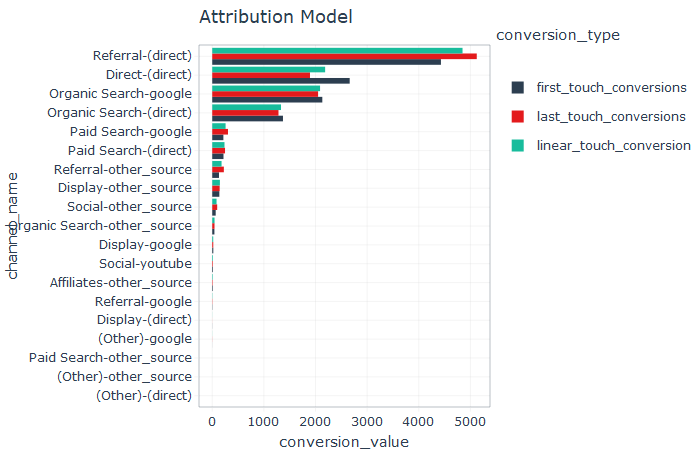
# Conversion Value
channel_path_heuristic_model %>%
select_at(vars(channel_name, matches("value"))) %>%
plot_attribution()
6 Markov Chain
markov_model <- channel_path_tbl %>%
markov_model_mp(
var_path = "channel_path",
var_conv = "conversion_total",
var_value = "conversion_value",
sep = ">",
order = 3,
nfold = 10,
seed = 123
)
## Number of simulations: 100000 - Convergence reached: 0.028860
# Conversion Count
markov_model %>%
select(-total_conversion_value) %>%
rename(markov = total_conversion) %>%
left_join(
channel_path_heuristic_model %>%
select_at(vars(channel_name, matches("conversions")))
) %>%
plot_attribution()
## Joining, by = "channel_name"
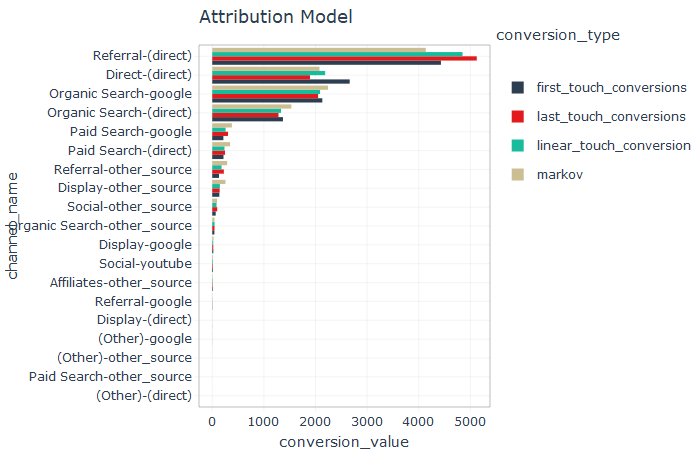
# Value
markov_model %>%
select(-total_conversion) %>%
rename(markov = total_conversion_value) %>%
left_join(
channel_path_heuristic_model %>%
select_at(vars(channel_name, matches("value")))
) %>%
plot_attribution()
## Joining, by = "channel_name"
7. Conclusion
It was a great introdction to Google Merchandise of Marketing Attribution with use of heuristics and Markov Chain.
8. Next Steps
- We will the Split Paths by Transactions
- Data Visualization of paths
- Use of Machine Learning - http://www0.cs.ucl.ac.uk/staff/w.zhang/rtb-papers/data-conv-att.pdf

